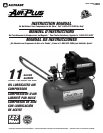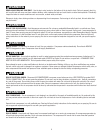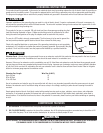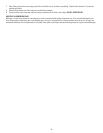
TOO MUCH AIR PRESSURE CAUSES A HAZARDOUS RISK OF BURSTING. CHECK THE MANUFACTURER'S MAXIMUM PRESSURE
RATING FOR AIR TOOLS AND ACCESSORIES. THE REGULATOR OUTLET PRESSURE MUST NEVER EXCEED THE MAXIMUM PRES-
SURE RATING.
7. Before connecting the compressor to the grounded outlet, check oil level, check for broken components and accessories, and
check for damage to the hose.
8. Plug power cord directly into a properly grounded power source of the correct voltage (see Grounding Instructions on page 7 of
this instruction manual).
9. Turn the compressor on by moving the switch to the AUTO/ON position and allow the tank pressure to build. Once the air pressure
reaches the maximum preset pressure (“cut-out” pressure) it will automatically shut off.
10. Slowly turn the pressure regulator knob clockwise to open airflow from air outlet port until desired output pressure is reached.
NOTE: The air compressor will automatically restart once the pressure in the air tank drops below the minimum preset pressure
(“cut-in” pressure).
SHUTDOWN:
NOTE: NEVER stop the air compressor by unplugging it from the power outlet as this may result in damage to the compressor.
1. Turn the switch to the OFF position
2. Disconnect the power cord from the power outlet.
3. Turn the pressure regulator knob fully counterclockwise to close airflow from air outlet port. Check the outlet pressure gauge to
ensure that it reads 0 PSI.
4. Remove the air hose and any air accessories.
5. Drain moisture from the air tank by slowly opening the air tank drain valve by turning clockwise. Tilt tank to remove all moisture.
Once all the moisture has drained out, close the fitting securely.
6. Allow the compressor to cool down.
7. Wipe the air compressor clean and store it in a clean, dry, and non-freezing location.
MAINTENANCE
DISCONNECT AIR COMPRESSOR FROM POWER SOURCE AND BLEED OFF ALL AIR PRESSURE BEFORE ATTEMPTING ANY MAINTE-
NANCE OR REPAIR.
When performing any maintenance or service:
1. The air compressor must be turned off.
2. Disconnect compressor from the power source.
3. Open tank drain to bleed off all air pressure before attempting any maintenance or repair.
4. Allow compressor to fully cool before attempting any maintenance or repair.
Check the air compressor frequently for any visible problems and follow maintenance procedures each time the compressor is used.
All air compressors contain maintenance parts that require periodic replacement. These used parts, including air filters and used lubri-
cating oil, may contain regulated substances that must be disposed of in accordance with local, state, and federal laws and regulations.
1. Turn compressor off and release pressure from the system. Drain moisture from the air tank by slowly opening the air tank drain
valve by turning clockwise. Tilt tank to remove all moisture. Once all the moisture has drained out, close the fitting securely.
2. Wipe the compressor clean.
Maintenance Checklist:
Daily:
Check oil level.
Drain accumulated liquid from tank.
11
WARNING
WARNING
NOTICE


















